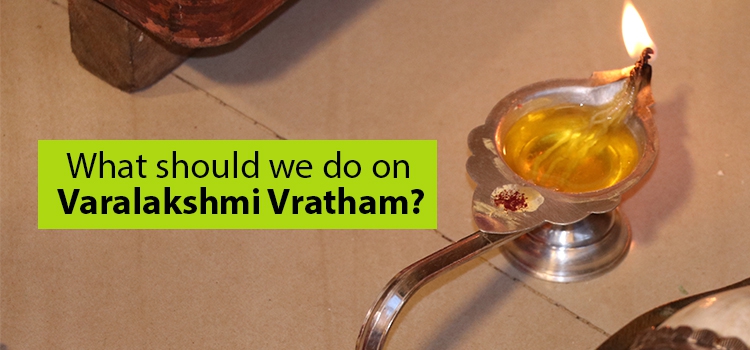What Should We Do on Varalakshmi Vratham?
Varalakshmi Vratham
Lakshmi is the Goddess of Wealth. Being the divine consort of the Supreme Protector Vishnu, she remains the universal Mother, who stands for auspiciousness, good fortune, love, and joy. Varalakshmi Vratham is a famous festival dedicated to this Goddess. ‘Vara’ is a boon, and Vara Lakshmi denotes the boon-giving form of the Goddess. Well-known as Vara Lakshmi Vratham, this ceremonious worship propitiates this boon-granting Mother Goddess and seeks Varalakshmi’s grace for the prosperity and welfare of the devotees and their families.
It is believed that worshiping the compassionate Goddess on the auspicious occasion of Varalakshmi Vratham amounts to offering prayers to Ashtalakshmi, all the 8 powerful aspects of Goddess Lakshmi.
Varalakshmi Vratham is observed on the second Friday of Shukla Paksha, the bright fortnight of the Moon, during Shravana month (July-August), or the Friday before the Full moon day of the month. This festival observed with piety and enthusiasm by married women is celebrated principally in the Southern states of Tamil Nadu, Kerala, Karnataka, Andhra Pradesh, and Telangana. Varalakshmi Vratham 2021 falls on 20th August 2021.

Varalakshmi Vratham: Invite Boon-Bestowing Goddess
Legend
According to the mythological story associated with the festival, once, a lady of Kundinyapura town in present-day Maharashtra by the name Charumathi remained very devoted to Goddess Lakshmi. Impressed with her faith, Lakshmi appeared in her dream and told the lady to worship her as Vara Lakshmi on the appointed day for getting her wishes fulfilled. Charumathi obeyed the Goddess’ command and performed the Pooja religiously, along with many other women of her place, chanting hymns in praise of the Goddess, offering sweets and other items, and following the worship procedures.
The legend also claims that this story was narrated by Lord Shiva himself to Goddess Parvati, and she herself did it seeking prosperity and joy. This came to be followed by the women, who began observing Varalakshmi Vratham for a host of blessings from the Goddess.
Varalakshmi Vratham Pooja Preparations
Varalakshmi Vratham Pooja is performed by the married with utmost devotion to the Goddess, following well laid down procedures and traditionally observed practices.
The central aspect of this worship consists of setting up a Kalash or Kalasam, a small pot usually made of silver or bronze, and installing the image or face of Goddess Lakshmi on it. It is to this image anointed on the sacred pot that the Varalakshmi Vratham Pooja is conducted.
The pot is placed facing East and is filled with water, in which spices like cardamom, camphor, nutmeg, turmeric, kumkum, dry fruits, etc., are added. There are also practices of filling the pot with raw rice, lemon, betel leaves and nuts, turmeric sticks, jaggery, black bead rosary, and coins, as per family traditions. Then a turmeric-applied coconut is placed on the pot, on top of 5 mango leaves, with its tail facing upwards. Kumkum is also then applied to the pot.
Saradu, the sacred thread, also forms an integral part of this worship. The thread is smeared with turmeric powder and hence remains yellow and consists of 9 knots made at equal intervals. These threads are generally distributed among the women devotees attending the Pooja, for tying in their wrists subsequently, as a form of Goddess’ protective blessings.
The house is cleaned and decorated with Kolams or Rangolis, the previous day itself. The oil lamps to be lit, the items and vessels to be used in the Pooja are also cleaned and kept ready for the worship the next day, the Friday of Varalakshmi Vratham.
Varalakshmi Vratham Pooja
The women of the house get up early in the morning on the Varalakshmi Vratham day, freshen up, and adorn themselves in silk Saris and ornaments. They also clean the Pooja spot, decorate it with rice flour Rangoli, place a wooden plank on it for installing the sacred pot, place a banana leaf on it, spread raw rice over it, and place the Kalasam on it. This pot will be covered with a new cloth, while an image of Goddess Lakshmi or her face made of silver will be fixed on the coconut in front.
The Goddess’ image is profusely decorated with a colorful dress, jewels (gold or otherwise), garlands, and flowers. A turmeric-applied sacred thread is also put around her neck, representing Mangalsutra. Next, Vermillion and sandal paste are applied to her forehead and face. Then traditional oil lamps are lit, and special food offerings made for the day are placed in front.
The worship begins with Ganesha Pooja when worship is offered to Lord Ganapathi, in the form of a cone made of turmeric paste, with the chanting of hymns.
The main Pooja of the occasion begins with inviting Goddess Varalakshmi to the house with hymns and offering Akshata, the turmeric-mixed rice, and flowers to her. Then Anga Pooja is performed, worshipping each of her body parts by chanting the appropriate slokas, and offering flowers to the pot.
Then Varalakshmi Vratham slokas are recited in praise of the Goddess, with the offering of flowers, and her 108 or 1008 sacred names are chanted. The offerings are then made to the Goddess, and Arti worship is done using water mixed with turmeric and kumkum to conclude the Pooja. The lady of the house wears the Saradu thread kept in the Pooja in her right wrist and also distributes threads to other ladies.
With complete devotion and faith, people can offer sincere prayers to the Goddess and earn her immense grace for eternal wealth, health, prosperity, welfare, and joy in the family.
Then, Thanboolam - the auspicious items like coconut, betel leaves, nuts, kumkum, turmeric, and flowers are all distributed to the women there, along with Prasadam, the offerings.
The Kalasam and image are taken out on the same night or the next day, after performing what is known as the Punar Pooja, the worship again, at an auspicious time.



















